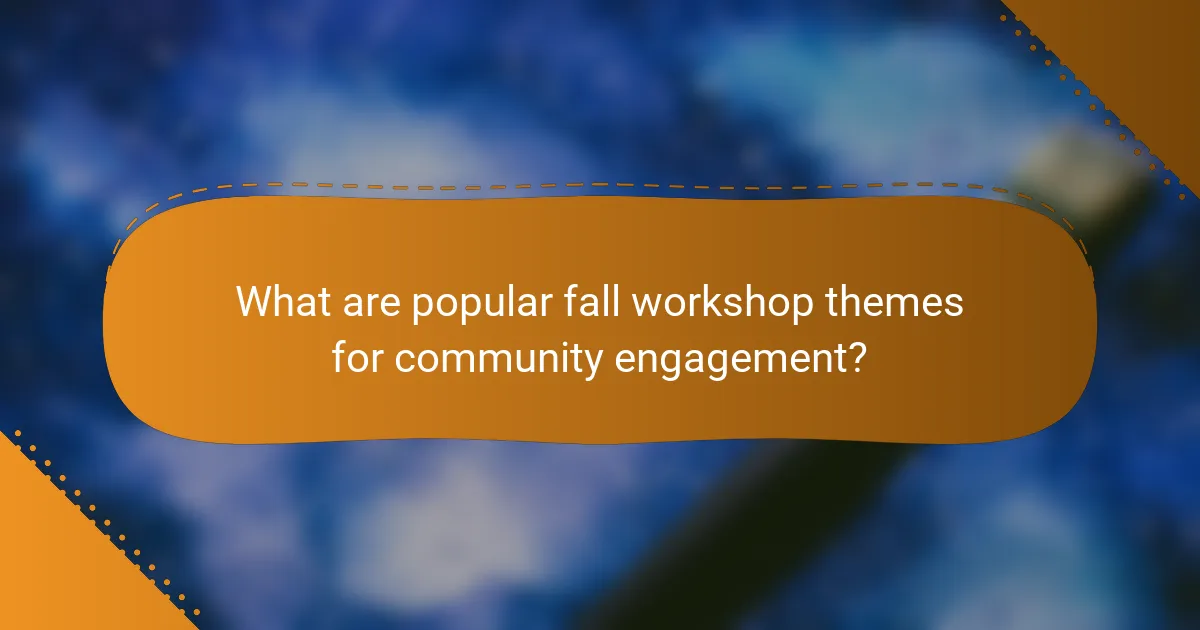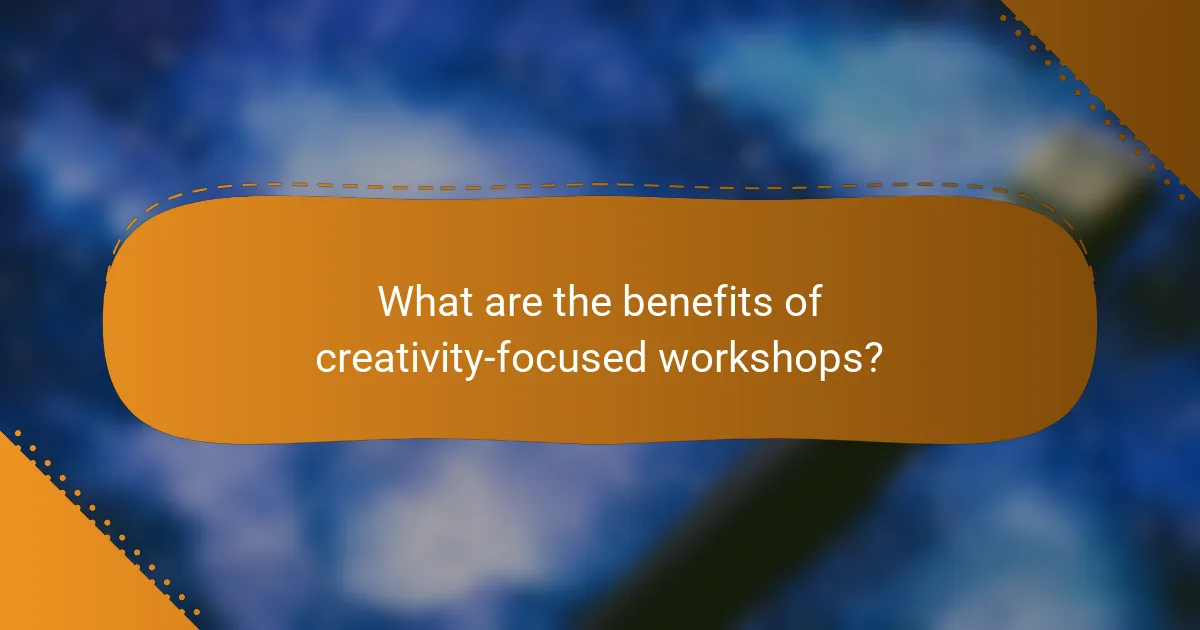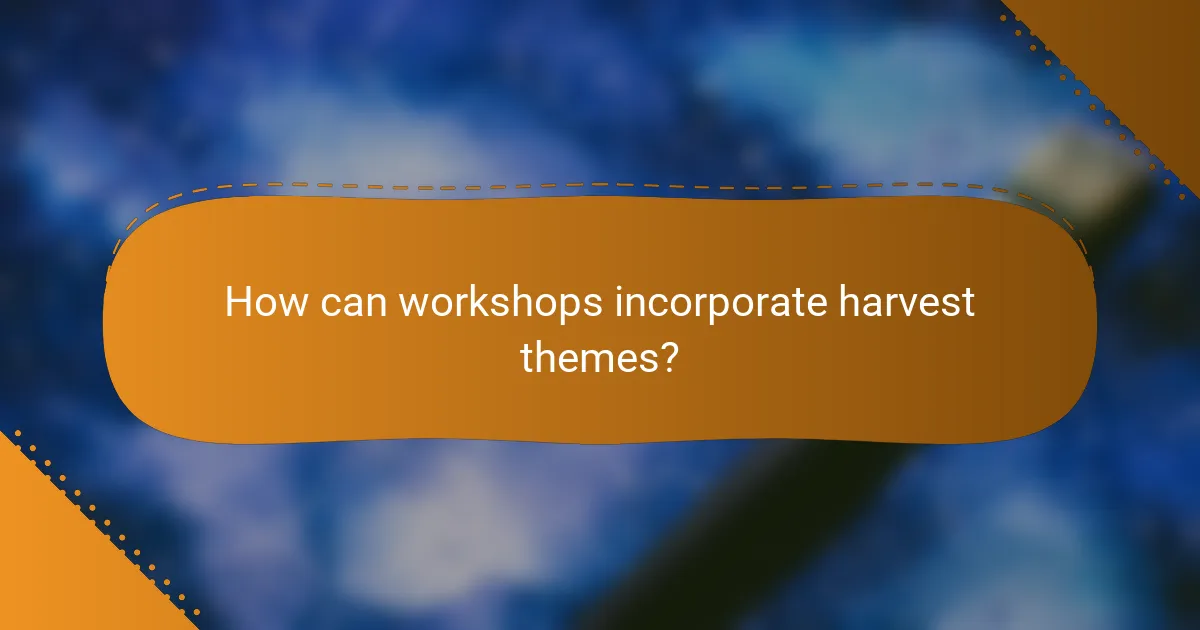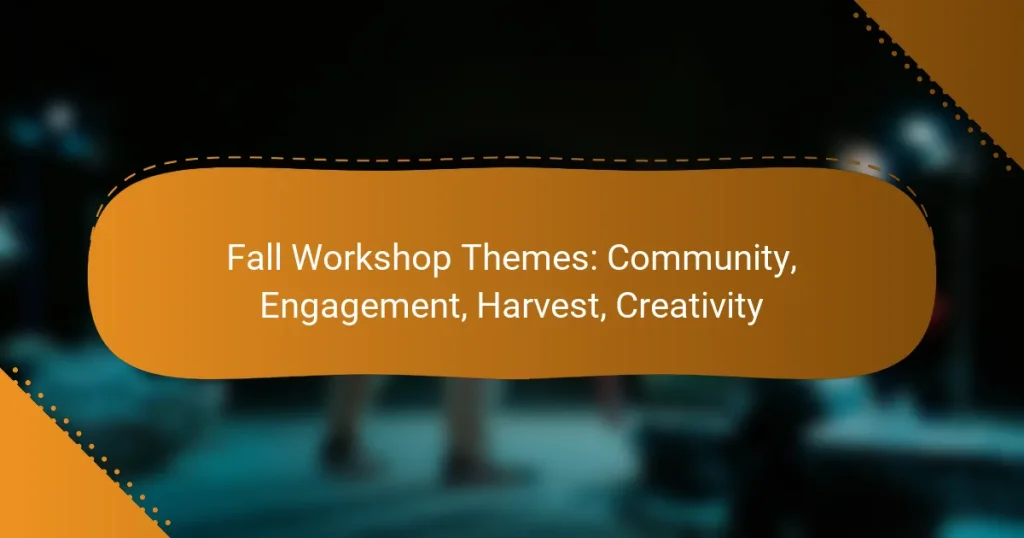As the fall season approaches, workshops centered around themes of community, engagement, harvest, and creativity offer a unique opportunity to connect and celebrate together. These interactive gatherings not only highlight the season’s bounty but also foster collaboration and a sense of belonging among participants. By incorporating hands-on activities, these workshops encourage individuals to share ideas and actively participate in local initiatives, enriching the community experience.

What are popular fall workshop themes for community engagement?
Popular fall workshop themes for community engagement focus on fostering connections among participants while celebrating the season’s bounty. These themes often include hands-on activities that encourage creativity, collaboration, and a sense of belonging within the community.
Harvest Festival Workshops
Harvest festival workshops celebrate the autumn season by bringing communities together to engage in traditional activities. These workshops often include apple picking, pumpkin carving, and making seasonal decorations. Participants can learn about local agriculture and the importance of sustainable practices.
Consider organizing events around local harvest dates to maximize participation. Collaborating with local farms can enhance the experience by providing fresh produce and educational insights.
Creative Arts and Crafts Sessions
Creative arts and crafts sessions allow community members to express themselves while creating seasonal decorations or gifts. Workshops can include activities like painting, pottery, or knitting, using materials that reflect the fall theme.
To attract a diverse group, offer sessions for various skill levels and age ranges. Providing all necessary materials can also encourage participation and reduce barriers for those new to crafting.
Local Food and Cooking Classes
Local food and cooking classes focus on using seasonal ingredients to create delicious meals. Participants can learn to prepare traditional fall dishes, emphasizing local produce and culinary techniques. This not only promotes healthy eating but also supports local farmers.
Consider partnering with local chefs or culinary schools to lead these classes. Offering classes at different times can accommodate various schedules, ensuring broader community involvement.
Outdoor Team-Building Activities
Outdoor team-building activities provide a fun way for community members to bond while enjoying the crisp fall weather. Activities can include scavenger hunts, obstacle courses, or group challenges that promote teamwork and communication.
When planning these activities, ensure they are accessible to all participants, regardless of physical ability. Incorporating elements of local culture or history can enhance the experience and foster a deeper connection to the community.
Seasonal Gardening Workshops
Seasonal gardening workshops teach participants how to prepare their gardens for the winter months. These workshops can cover topics such as planting fall crops, composting, and soil health, helping community members become more self-sufficient.
Offering hands-on demonstrations can make the learning experience more engaging. Providing resources like seed packets or gardening tools can encourage participants to apply what they’ve learned at home.

How can workshops enhance community engagement?
Workshops can significantly enhance community engagement by providing interactive platforms for individuals to connect, share ideas, and collaborate on common interests. These gatherings foster a sense of belonging and encourage active participation in local initiatives.
Building Local Networks
Workshops serve as a catalyst for building local networks by bringing together diverse groups of people with shared interests. Participants can meet like-minded individuals, which can lead to lasting friendships and professional connections. For instance, a community art workshop might unite local artists, art enthusiasts, and potential patrons.
To maximize networking opportunities, consider incorporating icebreaker activities or group discussions that encourage participants to share their backgrounds and interests. This approach helps create a welcoming atmosphere that promotes interaction.
Fostering Collaboration
Collaboration is a key benefit of workshops, as they provide a structured environment for participants to work together on projects or initiatives. By combining different skills and perspectives, groups can generate innovative solutions to community challenges. For example, a sustainability workshop might bring together residents, local businesses, and environmental experts to brainstorm eco-friendly practices.
Encourage collaboration by setting clear goals and providing resources that facilitate teamwork. Tools like brainstorming sessions or collaborative platforms can enhance the creative process and ensure that all voices are heard.
Encouraging Volunteerism
Workshops can inspire participants to engage in volunteer activities by showcasing the impact of community service. When individuals see the tangible benefits of their contributions, they are more likely to get involved. For instance, a workshop focused on food security might motivate attendees to volunteer at local food banks or community gardens.
To promote volunteerism, highlight local organizations that need support and provide information on how to get involved. Creating a follow-up plan for participants to sign up for volunteer opportunities can also help maintain momentum.
Creating Inclusive Spaces
Creating inclusive spaces in workshops is essential for ensuring that all community members feel welcome and valued. This can be achieved by considering accessibility, language diversity, and cultural sensitivities. For example, providing materials in multiple languages or ensuring physical accessibility can help reach a broader audience.
To foster inclusivity, actively seek feedback from participants about their experiences and needs. Implementing suggestions can enhance future workshops and demonstrate a commitment to creating a supportive environment for everyone.

What are effective strategies for organizing fall workshops?
Effective strategies for organizing fall workshops include identifying your target audience, utilizing social media for promotion, partnering with local businesses, and setting clear objectives. These approaches ensure that your workshops are engaging, well-attended, and aligned with community interests.
Identifying Target Audiences
Identifying your target audience is crucial for the success of your fall workshops. Consider demographics such as age, interests, and community involvement to tailor your content and outreach efforts. For example, workshops focused on harvest themes may attract families, while creativity workshops might appeal more to artists and hobbyists.
Conduct surveys or engage in community discussions to gather insights about what potential participants are looking for. This information can help you refine your workshop topics and formats to better meet their needs.
Utilizing Social Media for Promotion
Social media is a powerful tool for promoting fall workshops. Platforms like Facebook, Instagram, and Twitter allow you to reach a broad audience quickly and effectively. Create engaging posts that highlight workshop themes, dates, and benefits, and encourage sharing to increase visibility.
Consider using targeted ads to reach specific demographics within your community. Regular updates and reminders as the workshop date approaches can help maintain interest and boost attendance.
Partnering with Local Businesses
Partnering with local businesses can enhance your fall workshops by providing resources and increasing outreach. Collaborate with local farms, art studios, or community centers to co-host events or sponsor materials. This not only reduces costs but also taps into their customer base.
For instance, a local bakery might provide snacks for a creativity workshop, while a nearby farm could offer a venue for a harvest-themed event. Such partnerships can create a sense of community and shared purpose, making the workshops more appealing.
Setting Clear Objectives
Setting clear objectives is essential for guiding your fall workshops. Define what you aim to achieve, whether it’s community engagement, skill development, or simply providing a fun experience. This clarity will help shape your content and marketing strategies.
Establish measurable goals, such as a target number of participants or specific feedback metrics. Regularly assess your progress toward these objectives to make necessary adjustments and improve future workshops.

What are the benefits of creativity-focused workshops?
Creativity-focused workshops provide numerous advantages, including improved problem-solving abilities, enhanced mental wellbeing, and stronger community bonds. These workshops foster an environment where participants can explore their creative potential while engaging with others in meaningful ways.
Enhancing Problem-Solving Skills
Creativity-focused workshops enhance problem-solving skills by encouraging participants to think outside the box. Engaging in creative tasks helps individuals approach challenges from different angles, leading to innovative solutions. For example, brainstorming sessions can generate a variety of ideas that may not surface in traditional settings.
To maximize this benefit, facilitators can incorporate activities that require collaboration and critical thinking. Techniques like mind mapping or role-playing scenarios can stimulate diverse perspectives, making problem-solving more effective.
Boosting Mental Wellbeing
Participating in creativity-focused workshops can significantly boost mental wellbeing by providing a constructive outlet for self-expression. Engaging in creative activities has been linked to reduced stress levels and improved mood, as they allow individuals to channel their emotions positively.
To further enhance mental wellbeing, workshops can include mindfulness practices or relaxation techniques alongside creative tasks. This combination can help participants feel more centered and open to exploring their creativity without judgment.
Encouraging Self-Expression
Creativity-focused workshops encourage self-expression by providing a safe space for individuals to share their thoughts and feelings. Participants can explore various mediums, such as painting, writing, or music, which allows them to communicate their unique perspectives and experiences.
Facilitators should create an inclusive environment where all contributions are valued. This can be achieved through group discussions or feedback sessions that celebrate individual creativity and foster a sense of belonging.
Building Community Identity
These workshops play a crucial role in building community identity by bringing people together around shared creative interests. Participants often form connections that transcend individual differences, fostering a sense of unity and collective purpose.
To strengthen community ties, workshops can highlight local culture and traditions, encouraging participants to incorporate these elements into their creative projects. This approach not only enriches the workshop experience but also reinforces community pride and identity.

How can workshops incorporate harvest themes?
Workshops can effectively incorporate harvest themes by focusing on hands-on activities that celebrate seasonal produce and local resources. This approach fosters community engagement while promoting creativity and sustainability.
Farm-to-Table Cooking Classes
Farm-to-table cooking classes emphasize the use of fresh, locally sourced ingredients, allowing participants to connect with their food and the community. These classes typically involve visiting local farms or markets to select seasonal produce, followed by cooking sessions where participants learn to prepare dishes that highlight these ingredients.
When organizing these classes, consider the seasonal availability of produce in your area. For instance, in the fall, participants can work with pumpkins, squash, and root vegetables. Ensure to provide recipes that are simple yet showcase the flavors of the harvest.
To enhance the experience, include discussions on the benefits of supporting local agriculture and sustainable practices. Encourage participants to share their own cooking tips and experiences, fostering a sense of community and collaboration.
Seasonal Crafting with Natural Materials
Seasonal crafting workshops using natural materials allow participants to create unique, eco-friendly projects that reflect the beauty of the harvest season. This can include activities such as making wreaths from dried flowers, crafting decorations from gourds, or creating art with leaves and twigs.
When planning these workshops, gather materials that are readily available in your region during the fall. For example, consider using colorful autumn leaves, acorns, and pinecones. Provide guidance on techniques and project ideas while allowing participants the freedom to express their creativity.
To maximize engagement, incorporate storytelling about the significance of these materials and their cultural relevance. Encourage participants to share their creations, which can foster a sense of accomplishment and community spirit.


